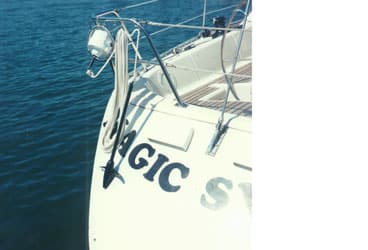
Ampair towed water generators on stern
You’re rigged correctly, all is well, and you’re enjoying a downwind passage. But to keep the lights on, the electronics running, and the beer cold, you will need electricity. In the July ’08 issue of Yachting World they had the results of a survey of boats participating in the Atlantic Rally for Cruisers. Boats that used their boat generators to produce electricity averaged 4.9 hours per day, while those that used their engines ran them on average 3.2 hours per day. This unnecessary running of engines or generators to produce electricity not only produces carbon dioxide and other things nasty to the global environment but since you are going downwind, the exhaust fumes are coming on board and blowing the length of the boat. Also the blessed silence one has under sail is disturbed by the noise of the engine.
Fortunately, there are other ways of producing electricity. Wind boat generators are almost useless on trade-wind passages as being dead downwind or almost, so the apparent wind across the boat is not sufficient to produce useful amounts of electricity.
Solar panels are great on multihulls, but on a monohull, there is not enough deck area to spread out enough solar panels to produce really useful amounts of electricity.
However hang an Ampair taffrail generator on your pushpit, toss over 60 feet of 1/2-inch braided line attached to a 12-inch propeller on a 3-foot rod, and let her run. At six knots this will produce at 12 volts 144 ampere-hours of electricity a day with a drag measured on a spring scales of 15 pounds. If you have a boat that is consistently doing over eight knots, Ampair has a high-speed prop that will not jump at the higher speeds.
To retrieve the propeller, split a 14-inch plastic funnel, slip it over the line, allow it to slide down the line, and the propeller will stop spinning. The propeller and line can be easily retrieved.
If 144 ampere-hours a day is insufficient for your needs, or if you consistently cruise in trade-wind conditions at a speed of eight or nine knots, 190 miles per day or more, you have two options install and aero gen or shaft generator.
The Ampair taffrail generator flattens out at 6 amps, whereas the DuoGen, once the speed is over 6 knots, the generating rate continues to climb. However, the DuoGen, because it requires a special mounting bracket on the stern is an expensive installation. One ARC boat reported the DuoGen was a good installation, but the total cost- DuoGen plus special brackets and wiring set him back £5,000 (US$8,120), whereas the Ampair generator is just hung from a sling on the pushpit and costs £750 (US$1,218).
For a lot less than the cost of a DuoGen, a shaft driven alternator can be installed that will produce more electricity than even the most electricity-hungry boats can use.
Shaft generators have been around for 60 years. The 39-foot Block Island schooner_ Lang Syne_ sailed around the world in 1948-49, with electric refrigeration and an electric autopilot, both of which used vast quantities of electricity, which was produced by a shaft generator.
Steve and Linda Dashew sailed around the world in the early 70s on Intermezzo a 55-foot aluminum cutter with all electricity produced by a low-rpm alternator driven by a 12-inch propeller. Correctly geared a low-rpm alternator driven by an 18-inch prop will produce 60 amps at 12 volts at six knots. This is more than enough electricity for even the most electrically hungry boats, and costs around $600 for the alternator, plus installation cost. Allow the prop to freewheel three or four hours a day to generate electricity, then lock the shaft to minimize drag.
Of course the ideal installation is with a variable-pitch prop. Adjust the pitch to maximize the rpm to generate electricity, and then once enough electricity is generated, feather the prop to minimize drag. Also under power a variable-pitch prop is more efficient than a fixed-pitch prop as with the variable-pitch prop, pitch can be adjusted to give the most efficient performance the given conditions.
With these effective alternative ways of generating electricity while underway, why run noisy, smelly, polluting generators when you can generate electricity silently and without harmful emissions?








